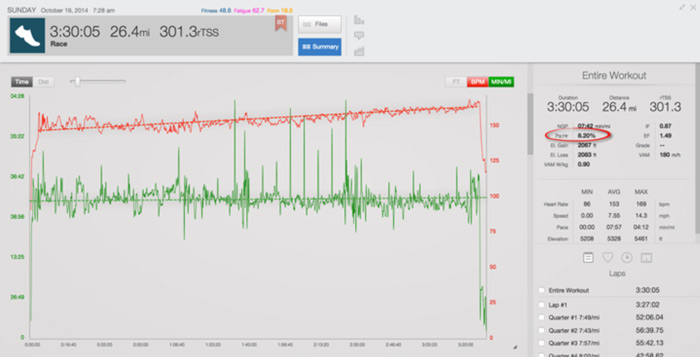In the last post we learned about the importance of determining and setting thresholds and how these numbers are used in TrainingPeaks to calculate the core metrics such as Intensity Factor and Training Stress Score.
In today’s post let’s build upon those concepts by introducing some new metrics that can help with race pacing and monitoring your progress.
What is Variability Index (VI)?
Variability Index is a metric that shows you how steadily paced (or variable) a workout was ridden. This can be a very important metric for time trialists or triathletes as pacing is the name of the game!
Variability Index is calculated by dividing your Normalized Power (or the estimate of the metabolic cost of the ride) with your average power.
The closer these two numbers are, the less variable the ride was and in turn the less energy that was wasted. For a steadily paced ride such as a time trial or triathlon bike leg, we would expect these numbers to be pretty close resulting in a VI of 1.05 or less.
If you happen to see a higher VI for one of these types of events then you might want to take a look at what kind of changes you could make to your pacing strategy.
On the other end of the spectrum, we have criteriums and mountain bike races which are quite variable and may result in a VI of 1.3 or higher.
Let’s take a look at the workout example below of an interval workout. This ride had an average power of 150 watts but the normalized power was 200 giving us a Variability Index of 1.32
How to use Variability Index
Take a look at a time trial or the bike leg of a triathlon. If your VI is 1.05 or less, you are doing a good job on pacing. If it’s higher, consider including some specific pacing drills into your regular bike workouts such as a cadence ladder or some steady-state intervals over a rolling course with the goal of minimizing the variability of each interval.

What is Efficiency Factor (EF)?
As the name implies, this metric is a way to measure efficiency during certain types of workouts as a way of looking at output versus input.
In order to ride your bike hard or knock out a 10K at race pace, your heart rate increases (input) to produce the power (output) to propel you along. As you become more fit you are able to do more work for less effort. In other words, you have become more efficient!
We get this number by dividing your output (power or pace) by your input (your heart rate). Note that this number is not useful on its own or for comparing yourself to other athletes. To make the best use of this number you would want to do similar steady state workouts over time and track the EF to monitor the progress of your training and its impact on your efficiency.
Note: because this metric is heart rate based it can be impacted by heat, stress, dehydration or other environmental factors.
How to Use Efficiency Factor
Schedule a steadily paced aerobic benchmark run or ride every one-to-two weeks and track the efficiency factor over time. Once your EF plateaus, it may be time to move on to the next phase of your training, or mix it up with some new workouts!

What is Decoupling (Pw:Hr/Pa:Hr)?
Finally we have Decoupling or Power to Heart Rate/Pace to Heart Rate Ratio. This metric is useful for demonstrating aerobic fitness over a given duration.
As an athlete starts to fatigue, their pace or power will drop for the same heart rate, or their heart rate will increase for the same power or pace. This phenomenon can be an indication of aerobic fitness or lack thereof.
In order to make use of this metric you will need a heart rate monitor and a way to record power on the bike or pace on the run. To determine Decoupling we compare the Efficiency Factors for the two halves of the workout or selected interval.
This comparison produces a percentage representing the decline in Efficiency Factor from one half to the next. As a rule of thumb, you are looking for a decoupling of 5 percent or less over the course of your target duration.
Note: because this metric is heart rate based it can be impacted by heat, stress, dehydration or other factors.
How to Use Decoupling
Take a look at your steadily paced, low VI, aerobic long runs or rides, if the decoupling is greater than 5 percent, then look at the environmental factors such as the temperature that day or your hydration status.
If those things seem normal then you may need some additional aerobic conditioning.
Consider adding in some additional Zone 2 workouts or revisiting the base phase.
See more about using Decoupling.


Today there are new training devices being introduced every day with the ability to measure almost anything you could imagine. By knowing what to measure (and what metrics matter to you most), you can ensure that you are working on the right things and will continue to see improvement in your training.



